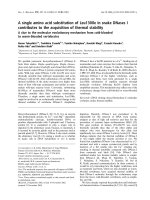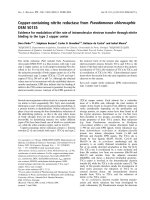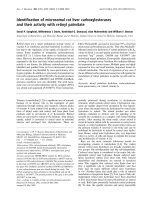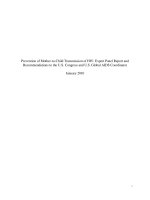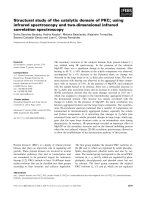Prevention of Mother-to-Child Transmission of HIV: Expert Panel Report and Recommendations to the U.S. Congress and U.S. Global AIDS Coordinator pot
Bạn đang xem bản rút gọn của tài liệu. Xem và tải ngay bản đầy đủ của tài liệu tại đây (1.2 MB, 151 trang )
i
Prevention of Mother-to-Child Transmission of HIV: Expert Panel Report and
Recommendations to the U.S. Congress and U.S. Global AIDS Coordinator
January 2010
ii
The independent Expert Panel issuing this report was established by Section 309 of the
Tom Lantos and Henry J. Hyde United States Global Leadership Against HIV/AIDS,
Tuberculosis, and Malaria Reauthorization Act of 2008 (“the Act”), P.L. 110-293. The
Panel was also established in accordance with the provisions of the Federal Advisory Committee
Act (FACA), as amended, codified in 5 U.S.C. App.
According to the Act, the objectives and the scope of the activities of the Expert Panel are to
“provide an objective review of activities to prevent mother-to-child transmission of HIV”
(human immunodeficiency virus, the pathogen that causes Acquired Immune Deficiency
Syndrome (AIDS); and to “provide recommendations to the Global AIDS Coordinator and
to the appropriate congressional committees for scale-up of prevention of mother-to-child
transmission prevention services under this Act in order to achieve the target established”
in the Act. The target is statutorily defined in Section 307 of the Act as “a target for the
prevention and treatment of mother-to-child transmission of HIV that, by 2013, will reach at
least 80 percent of pregnant women in those countries most affected by HIV/AIDS in which the
United States has HIV/AIDS programs.”
Members of the Expert Panel
Ministries of Health
Siripon Kanshana, Deputy Permanent Secretary, Ministry of Public Health, Thailand
Sam Zaramba, Director General of Health Services, Ministry of Health, Uganda
Implementing Organizations
Marie Deschamps, General Secretary, Gheskio
Laura Guay, Vice President of Research, Elizabeth Glaser Pediatric AIDS Foundation
Jeffrey Stringer, Director and CEO, CIDRZ Foundation
Researchers
William Blattner, Director, Institute for Human Virology, University of Maryland
Ruth Nduati, Professor of Pediatrics, Department of Pediatrics, University of Nairobi
Representatives from patient advocate groups, health care professionals, PLWHA, NGOs
Chewe Luo, Senior Advisor and PMTCT and Pediatric Treatment Team Leader, UNICEF
Peter McDermott, Chief Operating Officer, Children's Investment Fund Foundation
Gloria Ncanywa, Office Support Administrator, mothers2mothers
Martha Rogers, Director Center for Child Well-being, Task Force for Child Survival
Department of Health and Human Services
Lynne Mofenson, Branch Chief, Pediatric, Adolescent & Maternal AIDS, National Institute of
Health
R.J. Simonds, Medical Officer, Centers for Disease Control and Prevention
United States Agency for International Development
Margaret Brewinski, Senior Technical Advisor, Pediatric HIV and PMTCT, USAID
James Heiby, Medical Officer, USAID
The Panel is thankful to the following individuals for their important contributions to the report:
Charles Holmes, Andrea Swartzendruber, Funmi Adesanya and Alison Conforto.
iii
TABLE OF CONTENTS
Executive Summary
vi
Chapter 1. Global Burden of HIV among Women and Children, Introduction to
PMTCT, and Expert Panel Objectives
1
Chapter 2. PMTCT: Scientific Evidence
7
Chapter 3. The Effectiveness of Current Activities in Reaching Targets
56
Chapter 4. Barriers, Challenges and Potential Solutions for Optimizing PMTCT
Services
64
Chapter 5. Stigma as a Barrier to PMTCT Services
98
Chapter 6. Opportunities for Improved Linkages Between PMTCT and HIV Care
and Treatment
117
Chapter 7. OGAC/PEPFAR Collaboration with International and Multilateral
Entities on PMTCT
128
iv
Acronyms
AIDS Acquired immunodeficiency disease
AED Academy for Educational Development
AFASS Affordable, feasible, appropriate, safe, sustainable
ANC Antenatal care
ARV Antiretroviral drug
ART Antiretroviral therapy
AZT Azidothymidine/ zidovidine
CDC US Centers for Disease Control and Prevention
CHAI Clinton Health Access Initiative
CMMD Catholic Medical Mission Board
CTX Co-trimoxazole
DHHS Department of Health and Human Services
DNA Deoxyribonucleic acid
EGPAF Elizabeth Glaser Pediatric AIDS Foundation
EID Early infant HIV diagnosis
ESTHER Ensemble pour une Solidarité Thérapeutique Hospitalière en Réseau
FHI Family Health International
FP Family planning
GFATM Global Fund to Fight AIDS, Tuberculosis and Malaria
HAART Highly-active antiretroviral therapy
HBC Home-based care
HBD Home-based deliveries
HIV Human immunodeficiency virus
HCW Health Care Worker
IATT Inter-agency PMTCT Task Team
ICRH International Center for Reproductive Health
IEC Information, education and communication
IF Infant Feeding
M&E Monitoring and evaluation
MCH Maternal and child health
MNCH Maternal, neonatal and child health
MOH Ministry of health
MTCT Mother to Child Transmission
NGO Non-governmental organization
NVP Nevirapine
OB/GYN Obstetrician/ Gynecologist
OGAC Office of the Global AIDS Coordinator
OR Operational Research
OVC Orphans and vulnerable children
PBF Performance-based financing
PCR Polymerase chain reaction
PEPFAR President’s Emergency Plan for AIDS Relief
PHE Public Health Evaluation
PITC Provider Initiated Counseling and Testing
v
PMTCT Prevention of mother to child HIV transmission
PNC Postnatal care
QI Quality improvement
RFA Request for application
RH Reproductive health
sdNVP Single-dose nevirapine
SI Strategic Information
STI Sexually transmitted infection
TB Tuberculosis
TBA Traditional birth attendant
UNAIDS The Joint United Nations Programme on HIV/AIDS
UNICEF United Nations Children’s Fund
USAID United States Agency for International Development
USG United States Government
WHO The World Health Organization
vi
Executive Summary
Objectives
The independent Expert Panel issuing this report was established by Section 309 of the Tom
Lantos and Henry J. Hyde United States Global Leadership Against HIV/AIDS, Tuberculosis,
and Malaria Reauthorization Act of 2008 (“the Act”), P.L. 110-293. The Panel was also
established in accordance with the provisions of the Federal Advisory Committee Act (FACA),
as amended, codified in 5 U.S.C. App.
According to the Act, the objectives and the scope of the activities of the Expert Panel are to
“provide an objective review of activities to prevent mother-to-child transmission of HIV”
(human immunodeficiency virus, the pathogen that causes Acquired Immune Deficiency
Syndrome (AIDS); and to “provide recommendations to the Global AIDS Coordinator and to the
appropriate congressional committees for scale-up of prevention of mother-to-child transmission
prevention services under this Act in order to achieve the target established” in the Act. The
target is statutorily defined in Section 307 of the Act as “a target for the prevention and treatment
of mother-to-child transmission of HIV that, by 2013, will reach at least 80 percent of pregnant
women in those countries most affected by HIV/AIDS in which the United States has HIV/AIDS
programs.” Recommendations are made based upon an extensive literature search reviewing the
available evidence base on prevention of mother-to-child transmission (PMTCT) and through
discussions with additional experts in the field of PMTCT research and service implementation.
These recommendations are presented for the consideration of Members of Congress, the U.S.
Global AIDS Coordinator, and U.S. President’s Emergency Plan for AIDS Relief (PEPFAR)
field programs and headquarters staff, and other interested parties.
Introduction
According to the recently released joint World Health Organization (WHO), Joint
United Nations Programme on HIV/AIDS (UNAIDS) and United Nations Children’s Fund
(UNICEF) Universal Access report, 33.4 million people are estimated to be living with HIV
worldwide; 15.7 million of these are women and 2 million are children younger than 15 years of
age (UNAIDS, WHO, UNICEF 2009). HIV is the leading cause of mortality among women
of reproductive age worldwide and is a major contributor to maternal, infant and child
morbidity and mortality (WHO 2009; UNAIDS 2009). Without treatment, one third of
children living with HIV die before they reach one year of age and over 50% die by the second
year of life (Newell 2004). In 2008, an estimated 1.4 million pregnant women living with HIV in
low- and middle-income countries gave birth, 91% of whom reside in sub-Saharan Africa
(UNAIDS, 2009).
Without intervention, 25-40% of infants born to HIV-positive mothers will become infected.
With current interventions, this risk can be reduced to less than 5%. Therefore, transmission of
HIV from a pregnant woman to her infant is preventable. Effective provision of Prevention
of Mother-to-Child Transmission of HIV (PMTCT) interventions improves maternal
health and infant HIV-free survival. PMTCT is a key component of overall HIV prevention
efforts and represents a critical opportunity for stemming the tide of the HIV epidemic.
Comprehensive PMTCT consists of a 4-pronged approach:
vii
When comprehensively implemented, PMTCT holds the potential to:
• substantially reduce new pediatric HIV infections, as has been accomplished in
developed countries
• dramatically improve adult, maternal, infant and child health, particularly when
well integrated into maternal, newborn and child health (MNCH) settings and in
those countries where HIV contributes significantly to morbidity and mortality
• increase awareness of infection status for women and their partners and facilitate
access to comprehensive care, support and treatment services
• identify children of HIV-positive women who also need to be tested and, if
necessary, access HIV care, support and treatment services
• prevent new HIV infections in women and their male partners through prevention
approaches targeted to the infection status of an individual woman and her partner
• prevent unintended pregnancies among HIV-positive women
• promote appropriate reproductive health services including family planning for
those HIV-positive women who do not desire future pregnancies, and HIV
transmission prevention interventions for those who wish to become pregnant
• contribute to reductions in HIV-related stigma and discrimination through partner,
family and community education and awareness efforts
• help mitigate the disproportionate impact of HIV upon women and girls
• strengthen linkages between adult and pediatric treatment services available and
PMTCT services
• build capacity for HIV, MNCH and reproductive health systems through
education and training of health workers, improved laboratory and data systems,
infrastructural improvements of antenatal clinics and labor and delivery wards,
and strengthened systems for monitoring and evaluation
To successfully reduce mother-to-child transmission of HIV, population-level efforts to prevent
HIV infection among women of childbearing age must be realized. For the individual woman, a
comprehensive, coordinated continuum of services must be provided beginning with increased
access to counseling, testing, and primary prevention services, as well as reproductive health
choices enabling either the prevention of unintended pregnancies or appropriate planning for
intended future pregnancies for women living with HIV. For HIV-positive women who become
pregnant, access to and follow through on effective interventions to prevent transmission to the
infant and to provide treatment for the woman herself and her child if infected must be provided
Prong1
PreventionofHIV
infectionamong
womenof
childbearingage
Prong2
Preventionof
unintended
pregnanciesamong
womenlivingwith
HIV
Prong3
Preventionof
transmissionofHIV
frommothersliving
withHIVtotheir
infants
Prong4
Treatment,careand
supportformothers
livingwithHIVand
theirchildrenand
families
viii
to maximize maternal health and infant HIV-free survival. This continuum of services is often
referred to as the PMTCT cascade and includes:
1. Antenatal care attendance
2. HIV counseling and testing with same day return of results to the woman
3. Determination of eligibility for HIV treatment through CD4 count assessment (or less
optimally, through clinical staging) with rapid return of results to the woman and her
provider
4. Provision of antiretroviral therapy for women who require therapy for their own health
and antiretroviral prophylaxis to prevent mother-to-child transmission to women who do
not yet require therapy
5. Adherence to HIV treatment or prophylactic regimens as medically appropriate
6. Safe labor and delivery services
7. Timely provision of HIV prophylactic regimens and cotrimoxazole for the infant
8. Safe feeding practices for the infant
9. Early follow-up HIV testing for the infant with rapid initiation of antiretroviral treatment
for those who are infected, and testing to determine final HIV status in breastfed infants.
10. Ongoing, clinical, psychological and social care, support and monitoring for the mother,
infant and family
For optimal results, these services should be embedded within high-quality general maternal,
newborn, infant and child health services and supported by national and local government
commitment and funding, community sensitization and mobilization, male partner and other
family involvement, strengthening of health systems to promote comprehensive care and
treatment, accurate data collection, monitoring and evaluation, reliable supply of necessary
equipment and supplies and well-trained, patient-friendly health care workers.
Progress to Date
PMTCT has been a high priority for the international HIV/AIDS response as evidenced in the
Declaration of Commitment on HIV/AIDS adopted at the United Nations General Assembly
Special Session on HIV/AIDS in 2001 (United Nations 2001), the Abuja Call to Action Towards
an HIV-free and AIDS-free Generation in 2005 (High Level Global Partners, 2005), the Political
Declaration of the United Nations General Assembly High-Level Meeting on AIDS to work
towards universal access to HIV prevention, treatment, care and support in 2006 (UNGA 2006),
and numerous other high-level statements by multilateral organizations.
The United States Government (USG) has played a sustained and critical role in worldwide
PMTCT research and program efforts, including funding research that identified key PMTCT
interventions followed by spearheading global program scale-up of these interventions under the
2002 U.S. Mother and Child HIV Prevention Initiative and during the first 5 years of PEPFAR.
The PEPFAR reauthorization bill has brought a renewed emphasis to the urgent need for scale-
up of PMTCT services. Specifically, the bill calls for the establishment of a comprehensive,
integrated, 5-year strategy for PEPFAR, which must include a plan to help partner countries in
the effort to achieve goals of at least 80% access to counseling, testing, and treatment to prevent
the transmission of HIV from mother-to-child, emphasizing a continuum of care model, and
increase support for prevention of mother-to-child transmission. The PEPFAR Five-Year
ix
Strategy, released in December 2009, outlines plans to ensure that every partner country with a
generalized epidemic has both at least 80% coverage of testing for pregnant women at the
national level, and 85% coverage of antiretroviral drug prophylaxis and treatment, as indicated,
of women found to be HIV-infected (PEPFAR 2009). The policy also recognizes the work that
PEPFAR is doing to expand access to PMTCT to at-risk populations in countries with
concentrated epidemics. To help the children of these mothers, PEPFAR supports the expansion
of early infant diagnosis to reach 65% coverage, along with comprehensive care and treatment of
exposed infants.
Successful scale-up of PMTCT services is also well-aligned with the Obama administration’s
strong support for the empowerment of women and improving the health of women, children and
families through the Global Health Initiative (GHI), and contributes to Millennium Development
Goals 4 (Reduce Child Mortality), 5 (Improve Maternal Health) and 6 (Combat HIV/AIDS,
Malaria and Other Diseases).
Countries have realized significant achievements in PMTCT. According to the 2009 Universal
Access Report, 70 of 123 reporting low- and middle- income countries have established a
national PMTCT scale-up plan that includes population-based targets, up from 34 in 2005
(UNAIDS, WHO, UNICEF 2009). Due in part to increased implementation of provider-initiated
(‘opt out’) HIV testing in antenatal care (ANC) settings, rates of HIV counseling and testing for
pregnant women have improved. In six of the ten countries estimated to have the largest numbers
of pregnant women living with HIV (Kenya, Malawi, Mozambique, South Africa, Tanzania and
Zambia), rates of counseling and testing for pregnant women have risen to 60–80%. Progress has
also been made in providing antiretroviral medications for PMTCT to those women who test
positive. In 2008, 45% of pregnant women living with HIV in low- and middle-income countries
received antiretroviral drugs to prevent HIV transmission to their infants, including antiretroviral
therapy for their own health, an increase from 35% in 2006. However, half of countries with a
generalized HIV epidemic have an unmet need for family planning among married women age
15-49 years of over 25%.
In a supportive role for country-level leadership, PEPFAR has contributed significantly to many
of these achievements. Specifically, three of the fifteen original PEPFAR focus countries
(Botswana, Guyana, and South Africa) have achieved 80% coverage of HIV counseling and
testing among pregnant women with PEPFAR support, with several others close behind (Figure
1). Nigeria, in contrast, is behind and requires special intervention given its size, poverty and
gaps in health system capacity.
x
In 2008, three countries (Botswana, Guyana and Rwanda) achieved at least 80% antiretroviral
drug (ARV) provision among known HIV-positive pregnant women with PEPFAR support
(Figure 2). Sustaining these achievements and assisting the remaining countries to increase
coverage to at least 80% (regardless of antenatal care attendance), is essential for successfully
meeting the PMTCT goals outlined in the next phase of PEPFAR. It should also be noted that
PMTCT programs can contribute significantly to each of the PEPFAR goals of directly
supporting more than 4 million people on treatment, preventing 12 million new infections and
enrolling 12 million HIV-infected persons in care and support.
xi
Challenges
Despite the successes realized thus far, significant challenges remain to achieving at least 80%
coverage of counseling and testing for pregnant women and 80% coverage of ARV provision for
HIV-positive pregnant women. Comprehensive provision of PMTCT is a complex intervention
that involves multiple services delivered to different individuals at different points in time and in
a variety of different settings. For example, for any intervention to be provided, a woman’s HIV
status must first be determined. This would ideally happen in an ANC setting; however, many
women do not attend ANC services and those who do are unlikely to complete the WHO
recommended 4 visits throughout a pregnancy. Thus, expansion of testing to other settings
where women access services (eg. maternity wards, family planning clinics, immunization
clinics and other pediatric services, community health centers, etc.) will help to achieve this goal
and contribute to broader strengthening of women’s health. Women who test negative remain at
risk for acquiring HIV during pregnancy or lactation; thus engagement of their sexual partner in
xii
preventive services is an important target. Transmission of HIV to the infant is very high when a
woman acquires a new HIV infection during these time periods. Thus, women who test negative
who are in high HIV prevalence and/or high-risk settings need ongoing prevention interventions
and repeat testing during pregnancy. Women who test positive must be assessed for treatment
eligibility by CD4 test and clinical exam. Increased availability of CD4 tests in antenatal settings
is critically needed. The majority of pregnant women are clinically well, but as many as 50% are
likely to be eligible for treatment for their own health based on low CD4 count. Women who
receive a CD4 test typically wait 2 weeks or more for the results to return, necessitating a return
visit which can result in losing the woman to follow-up.
As pregnancy is only for a limited time, urgent intervention to provide treatment or prophylaxis
as quickly as possible is essential, or the window of opportunity to prevent HIV infection in the
infant may close. However, clinics providing antiretroviral therapy and ongoing management for
HIV-positive patients are not always located in the same place where the woman receives her
ANC and labor and delivery care. This is due to multiple factors including limited numbers of
health care workers trained in provision of such services, lack of appropriate infrastructure and
facilities and potentially long distances between health care sites and the individual woman’s
home. Thus, following up with these services may be extremely difficult. PMTCT services must
also be provided during labor and delivery. As many women deliver at home rather than in a
health facility, ensuring women and their babies have access to and take the needed antiretroviral
at the time of labor and delivery is very difficult. After delivery, the woman and infant need
ongoing monitoring, care and support and potentially treatment which poses yet another
challenge for reasons similar to those described above.
Moreover, risk of mother-to-child transmission of HIV does not end at birth but continues for as
long as the infant is breastfeeding. Women may not be able to reliably access appropriate infant
formula or the clean water needed to prepare it. Even if this can be accomplished, breastfeeding
is often the cultural norm, and formula feeding may draw scrutiny from friends and family,
potentially exposing the woman to stigma and discrimination, and leading to formula feeding in
private and breastfeeding in public. This ‘mixed’ feeding of part breast milk and part formula has
been shown to present the greatest risk for HIV transmission. Additionally, if formula feeding is
interrupted due to inadequate supply of formula or compromised by use of unsafe water for
preparation, infants are at extremely high risk for morbidity and mortality from other causes,
such as diarrhea and malnutrition, thus defeating the ultimate goal of HIV-free infant survival.
For these reasons, WHO infant feeding guidelines for HIV-positive women have recommended
exclusive breastfeeding for all women unless specific criteria for formula feeding can be met -
specifically formula feeding must be ‘AFASS’ (affordable, feasible, acceptable, safe and
sustainable). This conditional approach has been extremely difficult to implement and has
resulted in tremendous confusion among health care workers and mothers and likely contributed
to ongoing transmission during breastfeeding. Given recent clinical trial results demonstrating
that provision of antiretroviral drugs to the breastfeeding infant or lactating mother can
significantly decrease breast milk transmission, WHO now recommends that countries develop a
national plan for feeding guidance for all infants of HIV-positive women that should include a
comprehensive approach to health care access. If breastfeeding is chosen for national guidelines,
exclusive breastfeeding for 6 months followed by continued breastfeeding with appropriate
xiii
complementary feeding through age 12 months accompanied by antiretroviral prophylaxis of the
infant or mother to prevent breast milk HIV transmission is recommended.
Even if all of the programmatic challenges of making services available are met, agreeing to
testing, accepting a positive diagnosis and following through on the recommended interventions
places a tremendous burden on the individual woman especially given the weakness of health
systems and the impact of social barriers for women’s health, including stigma. Disclosure of
HIV infection to a partner, family or community member can be extremely daunting, and in
some cases even dangerous, for a woman who culturally may have very little decision-making
power and limited ability to provide for the needs of herself and her children. Stigma and
discrimination combined with very little male involvement in issues related to pregnancy and
childbirth and underlying cultural systems that disempower women create a situation that makes
it extremely challenging to follow through on essential PMTCT interventions.
An additional challenge has been ambiguity around the definition of PEPFAR targets and
whether the goals are PEPFAR program specific or whether they reflect national population level
coverage. Finally, provision of adequate PMTCT services is dependent upon sufficient funding.
As the USG, country governments and other donors face the reality of the current economic
crisis, availability of resources to support PMTCT programs is limited. Although PEPFAR has
recently allocated an additional one-time $100 million for strategic acceleration of PMTCT
scale-up in 6 countries in FY2010 (Malawi, Mozambique, Nigeria, Tanzania, South Africa, and
Zambia), PEPFAR resources overall have not increased as substantially in 2009 or 2010 as in the
program’s earliest years. As these additional funds are currently provided on a one-time basis, it
is difficult to strategize and plan for the scale-up of coverage on a long-term basis. While scale-
up of PMTCT services requires additional initial investments, and a broadened strategic
framework, the long-term savings, both in terms of improving maternal health, thus helping to
ensure a stable caregiver for children and a potential contributor to economic development,
political stabilization and in prevention of infections in infants who would otherwise go on to
require a lifetime of treatment, must be considered.
PEPFAR Expert PMTCT Panel Recommendations
The following recommendations of the PEPFAR Expert PMTCT Panel are directed to Members
of the U.S. Congress, the U.S. Global AIDS Coordinator and PEPFAR field programs and
headquarters staff. The Panel has summarized their recommendations below and organized them
by the following categories: 1) Service Delivery; 2) Health Workforce; 3) Health Information
Systems, Targets, and Monitoring and Evaluation; 4) Research and Innovation; 5) Financing; 6)
Leadership and Governance; and 7) Collaboration and Coordination, in order to demonstrate the
multisectoral approach needed to develop successful PMTCT programs, and to highlight the
ways in which PMTCT has wider impacts on country health systems.
A. Service Delivery:
1. The first two prongs of PMTCT (prevention of HIV infection and unintended
pregnancies) are often neglected but are crucial to the success of PMTCT and overall
HIV and global health efforts. PEPFAR should support and fund comprehensive
programs that include prevention of adult HIV infection, particularly for those women
found to be HIV-negative in PMTCT settings, provision of accurate family planning
xiv
advice and safe contraception for all women of childbearing age living with HIV, and
access to advanced health services if HIV-infected to prevent death of the mother and
child.
2. Routine, provider-initiated, opt-out HIV screening during pregnancy, delivery and the
postpartum period is essential to reduce the stigma of accessing the test, enabling women
to know their infection status and access treatment and care and PEPFAR should support
country efforts to make this standard policy and practice.
3. Given the dual benefits of improving maternal health and preventing new pediatric HIV
infections and in light of USG efforts to provide woman- and family-centered services,
PEPFAR should support policies that prioritize pregnant and lactating women for HIV
care and treatment services and work with governments to improve their longitudinal care
systems for PMTCT and linkages with care and treatment programs that aim to maximize
the health and survival of mothers and infants.
4. PEPFAR should support policies and practices that ensure that:
a. Pregnant women found to be HIV-positive are urgently assessed, preferably with
a CD4 cell count drawn on the day of diagnosis, to determine their need for
antiretroviral therapy for their own health, with the added benefit of dramatically
reducing transmission to the baby, and CD4 count assays need to be readily
available in the antenatal setting.
b. All HIV-positive pregnant women should be integrated into ongoing care and
those who are medically eligible for antiretroviral treatment for their own health
initiated on ART as soon as possible and continued on this therapy for life, along
with ongoing management of clinical, psychological and social issues.
c. Pregnant women not yet medically eligible for antiretroviral treatment for their
own health are integrated into ongoing medical monitoring and care and, urgently
started on a highly efficacious prophylactic ARV regimen to prevent in utero,
peripartum, and postpartum breast milk transmission to the baby, and are linked to
long-term follow up care to evaluate need for antiretroviral treatment and other
interventions in the future. This also facilitates monitoring of their exposed infant
for treatment services if infected and strengthens linkages for childhood
vaccination and other child health initiatives.
5. PEPFAR must contribute to putting programs in place that ensure all infants born to
mothers living with HIV are enrolled in ongoing care and support services and actively
followed to ensure clinical HIV-related and general pediatric management, early and
repeat HIV testing, developmentally appropriate psychological and social support,
provision of cotrimoxazole, appropriate infant feeding and, if indicated, ongoing
antiretroviral prophylaxis to further reduce the likelihood of transmission. These
programs should ensure that infants who are determined to be HIV-infected are initiated
on antiretroviral treatment given the high morbidity in untreated HIV-infected infants and
children.
6. PEPFAR and the broader GHI should strongly promote country-level integration and
coordination of PMTCT, HIV care and treatment programs, MNCH and family planning
programs to maximize the benefits of these investments.
7. PEPFAR should promote nutrition counseling and support with linkages to food security
programs as an integral component of PMTCT programs as pregnant women are under
xv
increased nutritional and metabolic demands, and often suffer from preventable
nutritional deficits, which are worsened by the additional burden of HIV infection.
8. PEPFAR programs and the wider GHI must focus additional resources to increase
demand for antenatal care services and outreach services for women who deliver at home
to increase the reach of PMTCT programs and potentially reduce stigma and loss to
follow-up.
9. PEPFAR should promote policies and programs that prioritize the inclusion of male
partners and other family members in PMTCT service delivery, as this has been shown to
improve test acceptance by women and reduce the stigma of positive test results.
Increased community and male partner knowledge, understanding, and participation in
PMTCT services as well as the provision of psychosocial support services to women are
critical in helping HIV-infected women successfully complete the PMTCT cascade, and
can lead to improvements in men’s health.
B. Health Workforce:
1. Improved and ongoing training, mentoring, supervision and appropriate compensation of
both professional and lay health care workers are needed to ensure quality services are
provided. Strengthening of local academic and technical educational institutions
including new curriculum and certification programs in the area of maternal and child
health and HIV are needed to achieve long-term sustainability. Training of health care
workers to provide PMTCT and related pediatric HIV treatment services should be
included in PEPFAR’s goal of training 140,000 new health care workers.
2. PEPFAR should use Partnership Frameworks to encourage country governments to allow
task-shifting, including non-physician health care worker initiation of antiretroviral
treatment for pregnant women, infants and children and the use of trained counselors to
provide HIV counseling and testing. Efforts should be made to utilize and compensate
HIV-positive women who have been through PMTCT services as counselors and
educators for new patients as their services have been successfully utilized in numerous
PEPFAR-funded programs. PEPFAR should allow for “topping-up” of salaries for public
health sector employees and incentivize productivity through performance-based
financing.
3. Fear of stigmatizing behaviors from health care workers is a barrier to service uptake.
PEPFAR should promote programs that focus on improving the counselor-patient
interaction and including formal training for staff on the reduction of stigmatizing
behaviors. They should address imbalances in quality of services offered at hospitals,
health centers and maternities by improving training of staff and infrastructure at all
venues.
C. Health Information Systems, Targets, and Monitoring and Evaluation:
1. The PEPFAR goals established in the Reauthorization and PEPFAR Five-Year Strategy
as related to target set for PMTCT counseling and testing, provision of prophylaxis, early
infant diagnosis, infants born HIV-free and pediatric testing and treatment must be better
defined to enable a clear strategy toward achieving them. PEPFAR leadership should:
a. Convene an interagency USG group to rapidly assess methodologies and gain
consensus on the definition of these targets for the next phase of PEPFAR.
xvi
b. Use national figures for all denominators used in PEPFAR reporting, and include
all women, regardless of antenatal care attendance.
c. Work with national monitoring and evaluation staff to promote disaggregation of
data provided to OGAC on the ARV regimens provided in their programs, as a
means of encouraging utilization of more efficacious regimens.
d. Define and measure targets that focus on providing HIV treatment to pregnant
women who need it for their own health, including documentation of clinical
and/or laboratory staging of HIV disease and engagement in care and/or treatment
services for all women identified as HIV-positive.
e. Strongly encourage establishment of reporting systems that provide an indicator
of linkage of HIV-infected women to treatment and care programs.
f. Establish indicators for and define program success in terms of PMTCT impact,
such as infant HIV-free survival.
2. Promote ownership of the PMTCT program through feedback of program results to
clinical sites and support of quality assurance (QA) and quality improvement (QI)
activities that allow for local identification of problems and generation of potential
solutions to improve program quality.
3. Conduct public health evaluation studies to identify the barriers to treatment and care and
the degree to which these barriers also negatively impact the completion of the PMTCT
cascade.
4. PEPFAR must support country-led efforts to move toward one monitoring and evaluation
system and international efforts to harmonize targets and indicators.
D. Research and Innovation:
1. Operational research is urgently needed to determine optimal strategies for
implementation of the PMTCT cascade. Research is particularly needed to ascertain
program models that facilitate integration of MNCH, PMTCT, and comprehensive care
and treatment services in a comprehensive, longitudinal, synergistic way to optimize
maternal, infant and child health and survival. A recent meeting convened by UNICEF
and the Elizabeth Glaser Pediatric AIDS Foundation, and attended by PMTCT and
pediatric HIV experts from the USG, international agencies and implementing partners
produced a list of 20 priority Operational Research questions reached by consensus
among all attendees. PEPFAR is in a position to rapidly facilitate answering these
questions and should fund, prioritize and fast track research in these areas through Public
Health Evaluations and other research and evaluation mechanisms.
2. As increasing numbers of HIV-infected pregnant women receive antiretroviral drugs
during pregnancy, surveillance for the effect of such treatments on maternal health,
pregnancy outcome, including birth defects, and the short- and long-term effects of in
utero antiretroviral drug exposure on their infants (including HIV-exposed but uninfected
infants) is critical. PEPFAR support of pharmacovigilance programs to monitor for such
effects is important.
3. PEPFAR should take a proactive approach to new interventions and development of new
technologies, including funding pilot projects to evaluate innovative and cost-effective
methodologies, such as point-of-care CD4 instruments and comprehensive provision of
PMTCT to promote women’s health and empower women to access services.
xvii
E. Financing:
1. Within PEPFAR, PMTCT should be prioritized for funding because it is one of the most
effective and cost-effective forms of HIV prevention and contributes to multiple
PEPFAR goals related to prevention, treatment, care and support, health care workforce
and health system strengthening and embodies a woman- and family-centered approach
to programming and foreign assistance funding.
2. PEPFAR should lead efforts to identify and implement cost-effective practices and
reduce inefficiencies at multiple levels, including within USG agencies, implementing
partners, country governments, and PEPFAR coordination with other donors.
F. Leadership and Governance:
1. PEPFAR should use the Partnership Framework as a means of improving country
government engagement and should take a proactive role in working effectively with all
stakeholders through effective national and international coordinating bodies. Strong
country government leadership that translates throughout the leadership to the local level,
prioritization of and commitment to PMTCT in the national HIV/AIDS plan and other
critical national HIV/AIDS activities and strategies such as Global Fund applications and
general health sector plans are required for rapid and comprehensive scale-up and
ongoing sustainability of PMTCT services. National coordination among relevant country
ministries (Health, Finance, Social Welfare, etc), USG agencies, implementing partners,
international agencies and faith-based organizations is required for the most effective and
efficient service provision.
2. Given staffing and capacity challenges often faced by national-level Ministries of Health,
PEPFAR programs should also emphasize staffing up and supporting Provincial and
District Health Offices as an effective method of promoting decentralization of country
leadership around PMTCT activities.
3. PEPFAR programs should work with host country governments to focus on concrete
efforts to reduce stigma and increase population-level understanding and acceptance of
PMTCT interventions.
4. PEPFAR policies should protect people living with HIV/AIDS (PLWHA) and engage
PLWHA in the development of country operational plans, Partnership Frameworks and
other key documents and planning.
G. Collaboration and Coordination:
1. PEPFAR leadership and technical experts should work closely with those responsible for
developing GHI strategy. There are tremendous opportunities for synergies and joint
efforts toward achieving common health and development goals related to PMTCT and
maternal, newborn, infant and child health. However, the approach must be developed
and implemented in harmony so as to reduce redundancy, achieve common goals,
capitalize on existing achievements and platforms and maximize sustainability.
Comprehensive implementation of PMTCT achieves the woman- and family-centered
approach articulated as a priority for USG initiatives.
2. In order to facilitate achievement of PMTCT goals, PEPFAR must:
a. Continue and expand coordination with international/multilateral organizations
within the framework of the “three ones” (one national HIV/AIDS action
framework, one national HIV/AIDS coordinating authority, one national
xviii
monitoring and evaluation system) based on the core competencies of the
different stakeholders to ensure clear and unified information is provided to
Ministries of Health and Finance.
b. Actively engage international/multilateral organizations in the PEPFAR
Partnership Framework process and coordinate where possible with the Global
Fund National Strategy Application process.
c. Provide support to improve capacity of international/multilateral organizations.
d. Continue to fully engage with the UNICEF/WHO co-convened Interagency Task
Team on PMTCT as the primary forum for coordination at headquarters level and
emphasize strong coordination at country level to avoid duplication and gaps.
e. Strengthen local governments and non-governmental organizations directly
involved in implementing best practices in order to translate PEPFAR’s successes
into long-term sustainable programs that are part of the fabric of health care
provided to women and children.
Conclusions
The members of the Expert Panel emphasize the importance of maximizing the extent to which
PMTCT, one of the most effective and cost-effective tools for the prevention of HIV, is funded
and scaled-up. If PEPFAR is able to reach its stated goals over the next 5 years, it will have the
effect of dramatically reducing new HIV infections and reducing the long-term costs of care and
treatment costs for infected children, and improving the health of women. These investments and
efforts should also be leveraged through the Administration’s GHI to achieve broader MNCH
and reproductive health goals through a woman-centered approach. Thank you for this
opportunity to share our insights and recommendations.
Members of the Expert Panel
Ministries of Health
Siripon Kanshana, Deputy Permanent Secretary, Ministry of Public Health, Thailand
Sam Zaramba, Director General of Health Services, Ministry of Health, Uganda
Implementing Organizations
Marie Deschamps, General Secretary, Gheskio
Laura Guay, Vice President of Research, Elizabeth Glaser Pediatric AIDS Foundation
Jeffrey Stringer, Director and CEO, CIDRZ Foundation
Researchers
William Blattner, Director, Institute for Human Virology, University of Maryland
Ruth Nduati, Professor of Pediatrics, Department of Pediatrics, University of Nairobi
Representatives from patient advocate groups, health care professionals, PLWHA, NGOs
Chewe Luo, Senior Advisor and PMTCT and Pediatric Treatment Team Leader, UNICEF
Peter McDermott, Chief Operating Officer, Children's Investment Fund Foundation
Gloria Ncanywa, Office Support Administrator, mothers2mothers
Martha Rogers, Director Center for Child Well-being, Task Force for Child Survival
Department of Health and Human Services
xix
Lynne Mofenson, Branch Chief, Pediatric, Adolescent & Maternal AIDS, National Institute of
Health
R.J. Simonds, Medical Officer, Centers for Disease Control and Prevention
United States Agency for International Development
Margaret Brewinski, Senior Technical Advisor, Pediatric HIV and PMTCT, USAID
James Heiby, Medical Officer, USAID
The Panel is thankful to the following individuals for their important contributions to the report:
Charles Holmes, Andrea Swartzendruber, Funmi Adesanya and Alison Conforto.
References
Prevention of Mother to Child Transmission (PMTCT) High Level Global Partners
Forum, Abuja, Nigeria, December 3, 2005. Call to Action:
Towards an HIV-free and AIDS-free generation.
(accessed
January 5, 2010)
Newell ML, Coovadia H, Cortina-Borja M, et al. Mortality of infected and uninfected infants
born to HIV-infected mothers in Africa: a pooled analysis. Lancet 2004;364:1236-43.
PEPFAR 5-Year Strategy. (accessed January 7, 2010)
UNAIDS/WHO/UNICEF. Towards universal access: Scaling up HIV services in the health
sector. Progress Report, 2009. (accessed
December 28, 2009)
UNAIDS/WHO 2009 AIDS Epidemic Update.
(accessed December
28, 2009).
United Nations. Declaration of Commitment on HIV/AIDS. 2001.
(accessed January 5, 2010)
UNGA. Political Declaration on HIV/AIDS.
/>df
World Health Organization. Women and health: today's evidence tomorrow's agenda. 2009.
/> (accessed January 5, 2010)
Global Burden of HIV Among Women and Children and Introduction to PMTCT
1
Chapter 1. Global Burden of HIV among Women and Children, Introduction to
Prevention of Mother to Child HIV Transmission (PMTCT), and Expert Panel Objectives
I. Introduction
The burden of HIV disease among women and children worldwide is staggering. It is the most
common cause of death among adult women worldwide, a leading cause of death among
children in low and middle-income countries, and has caused widespread suffering and reversal
of development advances in the hardest hit areas (UNAIDS, WHO, UNICEF 2009).
Comprehensive programs to combat vertical HIV transmission result in benefits for mothers,
children and families and are well-aligned with US Government (USG) development goals of
family and woman-centered initiatives.
II. Objectives
This chapter’s objectives are:
• To describe the global burden of HIV among women and children
• To present risk factors for mother to child HIV transmission
• To present the components of comprehensive Prevention of Mother to Child Transmission
(PMTCT) programs
• Introduce the objectives and members of the Expert Panel
III. Global Burden of HIV among Women and Children, Introduction to PMTCT Services
and Programs, and Expert Panel Objectives
Global Burden of HIV among Women and Children
HIV/AIDS continues to be the leading cause of illness and death among women and their
children, particularly in sub-Saharan Africa where HIV prevalence is highest. UNAIDS
estimates that 33.4 million people worldwide were living with HIV in 2008, including 15.7
million (47%) women (UNAIDS, 2009). Women in sub-Saharan Africa are disproportionately
affected; 60% of people living with HIV in sub-Saharan Africa are women (UNAIDS/WHO
2009). Globally, HIV prevalence varies substantially, ranging from <0.1% in places such as
Bosnia and Herzegovina and the Republic of Korea to 26.1% in Swaziland. Madagascar has the
lowest HIV prevalence in sub-Saharan Africa (0.1%), but seven other countries in that region
have prevalence ratios >10% (Botswana, Lesotho, Malawi, Mozambique, Namibia, South Africa,
Swaziland, Zambia) (Sweat 2004).
An estimated 1.5 million of the 115 million annual births in low- and middle-income countries
are born to HIV-infected mothers (Newell 2004).
Ninety percent of HIV-infected pregnant
women in need of ARVs for prophylaxis or treatment reside in twenty countries (Table 2). It is
estimated that 1,000 children under 15 years become infected with HIV every day; 90% of them
through mother-to-child HIV transmission and of that, 2 million children (6% of the 33 million
people living with HIV) are living with HIV (UNAIDS, WHO, UNICEF 2009). The majority of
these children (90%) live in sub-Saharan Africa, the most impacted and underserved region. HIV
infection in children is extremely aggressive and, unattended, will kill over 50% of children
before their second birthday (Newell 2004). In 2008, an estimated 280,000 children died of
AIDS (UNAIDS 2009).
Global Burden of HIV Among Women and Children and Introduction to PMTCT
2
Table 2. Twenty low- and middle-income countries with the highest estimated numbers
of pregnant women living with HIV in need of antiretrovirals to prevent mother-to-child
transmission of HIV and numbers of children in need of antiretroviral therapy (UNAIDS, WHO,
UNICEF 2009)
Risk Factors for Mother to Child HIV Transmission
While viral maternal and infant factors all influence the risk of vertical transmission, the most
important factor is the mother’s HIV viral load (the amount of virus in the mother’s blood). The
chances of transmission are higher when maternal viral load is high, as during new infection or
with advanced disease. Table 3 presents maternal factors that increase the risk of mother to child
HIV transmission during pregnancy, labor and delivery and breastfeeding.
Global Burden of HIV Among Women and Children and Introduction to PMTCT
3
Table 3. Factors that may increase the risk of HIV transmission
Pregnancy
High maternal plasma
viral load (new
infection or advanced
AIDS)
Viral, bacterial, or
parasitic placental
infection (eg,
malaria)
Sexually transmitted
infections (STIs)
Labor and Delivery
High maternal plasma and/or
genital viral load (new
infection or advanced AIDS)
Rupture of membranes more
than 4 hours before labor
begins
Vaginal delivery
Invasive delivery procedures
that increase contact with
mother's infected blood or
body fluids (eg, episiotomy,
fetal scalp monitoring)
First infant in multiple birth
Chorioamnionitis (from
untreated STI or other
infection)
Breastfeeding
High maternal plasma
and/or breast milk viral
load (new infection or
advanced AIDS)
Duration of breastfeeding
Early mixed feeding (eg,
food or fluids in addition
to breastmilk
Breast abscesses, nipple
fissures, mastitis
Oral disease in the baby
(eg, thrush or sores)
Source: WHO/HHS-CDC PMTCT Generic Training Package
Introduction to PMTCT
Without intervention, 25-40% of infants born to HIV-positive mothers will become infected.
With current interventions, this risk can be reduced to less than 5%. Ensuring provision of
maternal antiretroviral therapy for pregnant women who require treatment for their own health
and effective provision of PMTCT interventions improves maternal health and infant HIV free
survival and can substantially reduce pediatric HIV over time. PMTCT is a key component of
overall HIV prevention efforts and represents a critical opportunity for stemming the tide of the
HIV epidemic. Comprehensive PMTCT consists of a 4-pronged approach:
When comprehensively implemented, PMTCT holds the potential to:
Prong1
Primary
preventionofHIV
infectionamong
womenof
childbearingage
Prong2
Preventionof
unintended
pregnancies
amongwomen
livingwithHIV
Prong3
Preventionof
transmissionof
HIVfrom
mothersliving
withHIVtotheir
infants
Prong4
Treatment,care
andsupportfor
mothersliving
withHIVand
theirchildren
and families
Global Burden of HIV Among Women and Children and Introduction to PMTCT
4
• substantially reduce new pediatric HIV infections, as has been accomplished in
developed countries
• dramatically improve adult, maternal, infant and child health, particularly when well
integrated into maternal, newborn and child health (MNCH) settings and in those
countries where HIV contributes significantly to morbidity and mortality
• increase awareness of infection status for women and their partners and facilitate access
to comprehensive care, support and treatment services
• identify children of HIV-positive women who also need to be tested and, if necessary,
access HIV care, support and treatment services
• prevent new HIV infections in women and their male partners through prevention
approaches targeted to the infection status of an individual woman and her partner
• prevent unintended pregnancies among HIV-positive women
• promote appropriate reproductive health services including family planning for those
HIV-positive women who do not desire future pregnancies, and HIV transmission
prevention interventions for those who wish to become pregnant
• contribute to reductions in HIV-related stigma and discrimination through partner, family
and community education and awareness efforts
• help mitigate the disproportionate impact of HIV upon women and girls
• strengthen linkages between adult and pediatric treatment services available and PMTCT
services
• build capacity for HIV, MNCH and reproductive health systems through education and
training of health workers, improved laboratory and data systems, infrastructural
improvements of antenatal clinics and labor and delivery wards, and strengthened
systems for monitoring and evaluation
To successfully reduce mother-to-child transmission of HIV, population-level efforts to prevent
HIV infection among women of childbearing age must be realized. For the individual woman, a
comprehensive, coordinated continuum of services must be provided beginning with increased
access to counseling, testing, and primary prevention services, as well as reproductive health
choices enabling either the prevention of unintended pregnancies or appropriate planning for
intended future pregnancies for women living with HIV. For HIV-positive women who become
pregnant, access to and follow through on effective interventions to prevent transmission to the
infant and to provide treatment for the woman herself and her child if infected must be provided
to maximize maternal health and infant HIV-free survival. This continuum of services is often
referred to as the PMTCT cascade and includes:
11. Antenatal care attendance
12. HIV counseling and testing with same day return of results to the woman
13. Determination of eligibility for HIV treatment through CD4 count assessment (or less
optimally, through clinical staging) with rapid return of results to the woman and her
provider
14. Provision of antiretroviral therapy for women who require therapy for their own health
and antiretroviral prophylaxis to prevent mother-to-child transmission to women who do
not yet require therapy
15. Adherence to HIV treatment or prophylactic regimens as medically appropriate
16. Safe labor and delivery services
Global Burden of HIV Among Women and Children and Introduction to PMTCT
5
17. Timely provision of HIV prophylactic regimens and cotrimoxazole for the infant
18. Safe feeding practices for the infant
19. Early follow-up HIV testing for the infant with rapid initiation of antiretroviral treatment
for those who are infected, and testing to determine final HIV status in breastfed infants.
20. Ongoing, clinical, psychological and social care, support and monitoring for the mother,
infant and family
Expert Panel Objectives:
The Panel was established by Section 309 of the Tom Lantos and Henry J. Hyde United States
Global Leadership Against HIV/AIDS, Tuberculosis, and Malaria Reauthorization Act of 2008
(“the Act”), P.L. 110-293. The Panel was also established in accordance with the provisions of
the Federal Advisory Committee Act (FACA), as amended, codified in 5 U.S.C. App.
According to the Act, the objectives and the scope of the activities of the Panel are to “provide
an objective review of activities to prevent mother-to-child transmission of HIV” (human
immunodeficiency virus, the pathogen that causes Acquired Immune Deficiency Syndrome
(AIDS); and to “provide recommendations to the Global AIDS Coordinator and to the
appropriate congressional committees for scale-up of prevention of mother-to-child transmission
prevention services under this Act in order to achieve the target established” in the Act. The
target is statutorily defined in Section 307 of the Act as “a target for the prevention and treatment
of mother-to-child transmission of HIV that, by 2013, will reach at least 80 percent of pregnant
women in those countries most affected by HIV/AIDS in which the United States has HIV/AIDS
programs.” The Panel was asked to perform the following duties:
1. Assess the effectiveness of current activities in reaching the target for prevention of
mother-to-child transmission established in the Act;
2. Review scientific evidence related to the provision of mother-to-child transmission
prevention services, including programmatic data and data from clinical trials;
3. Review and assess ways in which the Office of the United States Global AIDS
Coordinator collaborates with international and multilateral entities on efforts to prevent
mother-to-child transmission of HIV in affected countries;
4. Identify barriers and challenges to increasing access to mother-to-child transmission
prevention services and evaluate potential mechanisms to alleviate those barriers and
challenges;
5. Identify the extent to which stigma has hindered pregnant women from obtaining HIV
counseling and testing or returning for results, and provide recommendations to address
such stigma and its effects;
6. Identify opportunities to improve linkages between mother-to-child transmission
prevention services and care and treatment programs; and
7. Recommend specific activities to facilitate reaching the target established in the Act.
References
Newell ML, Coovadia H, Cortina-Borja M, et al. Mortality of infected and uninfected infants
born to HIV-infected mothers in Africa: a pooled analysis. Lancet. 2004;364:1236-43.
Global Burden of HIV Among Women and Children and Introduction to PMTCT
6
Sweat MD; O'Reilly KR; Schmid GP; Denison J; de Zoysa I; Cost-effectiveness of nevirapine
toprevent mother-to-child HIV transmission in eight African countries. AIDS 2004;18:1661-
1671.
UNAIDS/WHO 2009 AIDS Epidemic Update.
(accessed December
28, 2009).
UNAIDS/WHO/UNICEF. Towards universal access: Scaling up HIV services in the health
sector. Progress Report, 2009. (accessed
December 28, 2009)

